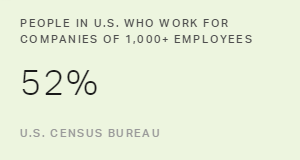Story Highlights
- Employees in large companies less engaged than in smaller ones
- Big businesses are getting bigger, but not more profitable
- Investing in employee engagement can lead to greater profits
When it comes to how engaged employees are with their companies, organization size matters.
Employees who work for larger companies with more than 1,000 workers report lower levels of engagement than those who work for smaller firms with fewer than 1,000 employees. The engagement gap widens for employees who work for companies with more than 5,000 workers, as these individuals report lower average results on nearly all of Gallup's engagement items than in firms with fewer than 1,000 employees.

Gallup analysis shows that the 1,000-employee mark seems to be the tipping point for declining engagement with a company. When an organization reaches this size, a smaller percentage of employees strongly agree that they have the opportunity to do what they do best every day and that their organization's mission or purpose makes them feel their job is important. A smaller percentage also strongly agree that they have the materials and equipment to do their job right and that they have opportunities at work to learn and grow.
This engagement gap is a major problem with serious financial implications. Large firms play a significant role in the U.S. economy, employing almost 60 million people, or 52% of all workers, according to the U.S. Census Bureau. They generally offer a wider range of employment opportunities, higher wages, and better benefits and provide greater job stability than smaller firms.
As large companies acquire competitors and major mergers occur in the marketplace, big businesses are getting bigger. But this doesn't necessarily mean that large companies are making more money. To ensure profitability and longevity in the always-evolving U.S. economy, large organizations need to invest in their greatest asset: their employees. Gallup finds that high levels of employee engagement lead to better performance through fewer quality defects and safety incidents and less shrinkage, turnover and absenteeism. These elements add up to higher productivity and profitability.
There is one area in which larger companies outperform smaller ones on the engagement spectrum. Employees of larger companies are more likely to strongly agree that someone has talked to them about their progress than employees of smaller firms. However, given that workers at large businesses are less likely to strongly agree that they had the opportunity to learn and grow or that their opinion counts, this interaction is likely more of a status check-in than an in-depth development conversation.
What Larger Companies Can Do
Here are some steps larger companies can take to boost engagement in their workforces:
Establish effective feedback systems. Large companies often struggle with the top-down flow of information from leaders to the front line. The problem gets worse when the information needs to flow uphill. To meet employees' information needs and ensure that workers feel that leaders hear their opinions, companies need to establish working channels to gather feedback from all levels of the organization.
Some leaders have an open-door policy, and this can bolster employees' perceptions that their opinions count. But unless the organizational culture truly embraces employee feedback -- and workers feel managers or leaders won't punish them if they share information -- employees will probably share their opinions with one another but not up the line.
Create opportunities for employees to learn and grow. In small companies, employees often take on multiple roles. As companies grow, employees need more information about their opportunities for learning and growing. Working on different projects or project teams allows employees to contribute their talent in different ways, helping them build their skills and internal networks.
Managers are the key to helping employees develop. A manager needs to understand his or her employees' development goals to help them cultivate their talents by creating a development plan. Gallup knows that good managers support employee engagement and bad managers and disengaged employees cost companies money.
Take advantage of regular check-ins. The best type of feedback is effective and ongoing. However, if companies already schedule formal performance review sessions, managers can use these meetings to ask employees what they need to improve their performance and grow in their career. Making the most of performance reviews is vital for large companies that seem to be "checking the box" when it comes to these meetings instead of using this time for uncovering barriers and helping employees to maximize their potential.